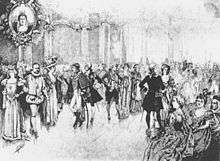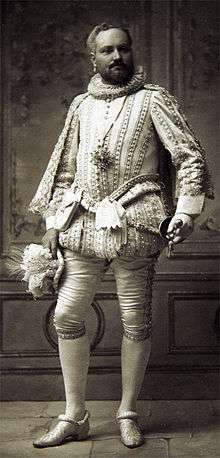Bradley-Martin Ball

The Bradley-Martin Ball was a lavish costume ball at the Waldorf Hotel in New York City on the night of February 10, 1897. Cornelia Bradley-Martin organized the ball, with the intention of making it "the greatest party in the history of the city". Eight hundred socialites spent about $400,000 imitating kings and queens.[1] Bradley-Martin's stated intention was to create an economic stimulus for New York City, which was at the end of the Long Depression which began in 1873 and included the Panic of 1893. The Bradley-Martins spent approximately $9.7 million in today's money to throw the ball. Across the country, preachers and editorial writers argued over the propriety of a party that would cost hundreds of thousands of dollars. In the end, the ball was a social triumph but created negative publicity.[2]
Before the Ball
In the three weeks leading up to it, New York society made the ball its one topic of discussion. The Commercial Advertiser exclaimed: "There is a great stir today in fashionable circles and even in public circles. The cause of it all is the Bradley Martin ball, beside which the arbitration treaty, the Cuban question, and the Lexow investigation seem to have become secondary matters of public interest."[3] The Bradley-Martins drew fire from all directions, as newspapers criticized its extravagance and during their sermons, clergymen urged their congregations not to attend. One clergyman denounced the ball by saying: "You rich people put next to nothing in the collection plate, and yet you’ll spend thousands of dollars on Mrs. Bradley-Martin’s ball”.[1] The guests included: Caroline Webster Schermerhorn Astor, known simply as Mrs. Astor, costumed as Mary, Queen of Scots, her son John Jacob Astor as Henry IV of France and his wife as Marie Antoinette[4] , James L. Breese as the Duke of Guise, John Pierpont Morgan, Charles Childs as Lady Teazle, Hermann Oelrichs as a Dutch Bergomaster, Charles Post as Madame de Maintenon, Stanford White in a Court costume of black velvet and white satin, the artist Adolfo Müller-Ury as a Spanish toreador, Pierpont Morgan as Louise of Mecklenburg-Strelitz, and Hamilton Fish Webster as Maria Theresa of Austria.[5]
Concept
Cornelia Bradley-Martin’s idea was to give a costume ball at so short notice that her guests would not have time to get their dresses from Paris, and instead support local businesses.[1] This overlapped with the idea that it was much better for the laboring people if the wealthy spent their money locally instead of taking it to Europe.[6]
The Reverend Dr. Rainsford believed in the rich giving money to be distributed as charity, whereas others, including the members of the Musical Mutual Protective Union (MMPU), disagreed. They believed in the wealthy spending their wealth in enjoying themselves, and thus giving hundreds and thousands of working people an opportunity to earn money and maintain their self-respect instead of having to accept charity. The MMPU became indignant when they heard that the Marine Band was to be at the ball instead of musicians from their union. The members of the Marine Band did not urgently need the money that they were going to receive from the ball.[7]
Preparations
Florist Small was in charge of the decorations for the Bradley-Martin ball. Decorating the Waldorf began on the morning of February 9 by A.W. Merritt, Small’s colleague. In the days leading up to the event, dealers’ stocks and household stores were ransacked to supply the demand for ornaments and historical accuracy. All the jewelers who dealt in antiques were cleaned out of all they had on hand. Jewels held as heirlooms by the old families of New York were taken from safety vaults. Laces that had been locked away in family chests or in safe deposit vaults for long years had been retrieved.[8]
Twelve hundred invitations were issued for the event, and more than half of those invited were in attendance. Some who did come also left early, seeming to have made an appearance out of curiosity.[9]
The Waldorf
"The interior of the Waldorf-Astoria Hotel was transformed into a replica of Versailles, and rare tapestries, beautiful flowers and countless lights made an effective background for the wonderful gowns and their wearers."[1]
Police officers stood guard at the entrance to the Waldorf. The Bradley-Martins arrived first at 10:15 pm. At half past 10 a group of carriages arrived and before 11 the stream of guests had become continuous. The guests were ushered into the Waldorf, whereupon they ascended to the corridors on the second floor where 15 dressing rooms were available for the use and comfort of the guests.[9] Some guests, preferring not to expose themselves on the street while wearing tempting fortunes in jewels and laces, changed into their costumes at this point. This wasn’t done through any feeling of fear, but merely as a wise precaution.[8] Wigmakers and make-up artists were available in these rooms. When leaving the dressing rooms the guests headed to the smaller ballroom. It was here where Cornelia Bradley-Martin received her guests. A lackey announced the guests’ names and the characters they impersonated to her. This stream of guests poured by her for nearly 90 minutes and it was after midnight before she was able to enter the main ballroom to take her place in the opening quadrille d’honneur.[9]

Costumes
Cornelia Bradley-Martin requested her guests to pick something from the 16th, 17th, or 18th centuries, and some came dressed as George Washington, a Japanese nobleman, an Egyptian princess and Pocahontas. A list was compiled and published in the New York Times three days prior to the event, listing guests and the historical characters they were going to impersonate and what costumes they were going to wear.[5] Bradley-Martin "personated Mary Stuart, and her gold embroidered gown was trimmed with pearls and precious stones worth more than $60,000. Bradley (Martin), as Louis XV, wore a Court suit of brocade".[1] "In many cases the diamond buttons worn by the men represented thousands of dollars, and the value of the historic gems worn by the ladies baffles description."[1] At the time, the average income of an American was $400 a year.[3]
Otto Cushing, a young artist from Boston, created quite a stir when he appeared as an Italian falconer's costume which consisted of full body tights, a short jacket and a cap with a stuffed falcon on one arm. "The costume left little to the imagination as far as the figure was concerned, and, although historically correct in every detail, was so decidedly pronounced that he made a sensation wherever he moved."[10]
Decorations
The smaller ballroom was set throughout with furniture of the Louis XV period, and the walls were hung with tapestry draperies. Roses were hurled en masse against the draperies and let remain where they landed. The side of the room, where the Hungarian band was placed, was concealed by long-stemmed roses and garlands were dropped from the center to each side and over the mirrors.[9] The Hungarian Band, under the leadership of Carl Berlinger, played 12 concert selections, chosen by Mrs. Bradley-Martin, throughout the evening.[5]
Upon entering the grand ballroom the guests faced a wall in which 15 mirrors were imbedded. The far side of the room, the musicians’ balcony, was concealed by pink roses, with garlands also hanging from above. There were over 5,000 roses and 3,000 orchids in these various groupings.[9]
The café and the court were also decorated, with a desired homelike effect.[9] 125 tables were set up, each to accommodate six guests, with a centerpiece of Beauty roses.[5]
Music
The danse d’honneur, arranged by Caroline Astor, opened the ball. The company was led by Cornelia Bradley-Martin, in the role of the Queen, escorted by John Jacob Astor as the King. For this danse d’honneur, the orchestra played music composed by Beethoven. Following this, the orchestra started playing one of Chopin’s polonaises announcing the approach of the wife of Edmund L. Baylies and her associates for the minuet. When they formed for the minuet the orchestra struck into Mozart’s dance music out of "Don Giovanni". The dance of the debutantes was next, and it was livelier than the others and the most difficult of all. The members of this set, organized by the wife of Frederic Bronson, danced a Hungarian Court quadrille, the Kormagyar, in music arranged by Allen Dodworth.[9] This quadrille ended the exhibition dances. General dancing followed the three quadrilles until supper time.[5]

Supper
"Between the grand ballroom and the cafe, used on this occasion for the supper room, is a barricade of windows, which were thrown open about 1 o'clock in the morning, and the guests were then at liberty to enjoy the delights of the cuisine. The menu was as follows:
- CHAUD
- Consommé de Volaille
- Bouillon de Clovis
- Homard à la Newburg
- Huitres à la Viennoise
- Poularde farcie aux truffes
- Filet de Boeuf Jardinière
- Terrapene désossée à la Baltimore
- Canard canvasback
- FROID
- Galantine à la Victoria
- Terrine de Foie Gras
- Cailles piquées à la Gelce
- Chaud-froid de Pluviers
- Jambon en Danier
- Mayonnaise de Volaille
- ENTREMETS DE DOUCEUR
Entertainment and Favors
The cotillion commenced at three, and spectators found amusement as the gentlemen danced it with swords at their sides. Swords got tangled in gowns and laces, and courtiers tripped over them, to the delight of the spectators. Elisha Dyer, Jr. led the cotillion.[9]
Cornelia Bradley-Martin selected small silver figures and a staff as “favors” for each of the guests of the ball. The “favors” were awarded by Elisha Dyer, Jr. as leader of the cotillion.[9]
Reaction and Controversy
After the ball many ministers preached against its excessive consumption and the authorities promptly raised Bradley-Martin’s taxes (as well as those of their friends and fellow-attendees the Astors) quite out of proportion to those paid by anyone else. The Bradley-Martins returned to England, where they had owned a home for several years, and Scotland, where they leased a 65,000-acre (260 km2) estate, Balmacaan.[4]
Although historians have repeated oft-told half-truths without conducting primary research, the Bradley-Martin ball is perhaps best-remembered as the end of the excesses of the Gilded Age.
Notes
- 1 2 3 4 5 6 Martin, Frederick Townsend (1913). Things I Remember (1913). New York: John Lane Company. pp. 280–285. ISBN 0-548-83545-4.
- ↑ McGerr, Michael. A Fierce Discontent. Oxford University Press, Inc. NY, pages 4-6, 2003.
- 1 2 http://www.oldandsold.com/articles08/waldorf-astoria-10.shtml
- 1 2 Hutto, Richard Jay (February 1997). "The Party of the Century". Quest: 52–57.
- 1 2 3 4 5 "The Bradley Martin Ball: Preparations Nearly Completed for an Entertainment in Society Which Promises to be Historic." The New York Times 7 February 1897.
- ↑ “Talked on the Coming Ball: Mr. Gunton Thinks the Rich Should Spend Their Money Here.” The New York Times 4 February 1897.
- ↑ “Musicians are Indignant: They Hear that the Marine Band Is to be at the Bradley-Martin Ball, and Condemn Dr. Rainsford.” The New York Times 30 January 1897.
- 1 2 “The Bradley Martin Ball: A Wealth of Heirlooms, in Antique Jewels and Rare Old Laces, to be Shown.” The New York Times 9 February 1897.
- 1 2 3 4 5 6 7 8 9 “Bradley Martin Ball: Not so Many Guests Attended the Function at The Waldorf as Had Been Expected.” The New York Times 11 February 1897.
- ↑ "Echoes of the Big Ball". New York Times. February 12, 1897. Retrieved 2008-06-27.
External links
- The Bradley Martin Ball 2-10-1897, TheHistoryBox.com, Source: The New York Times, February 11, 1897
- Waldorf-Astoria- Famous Dinners and Balls